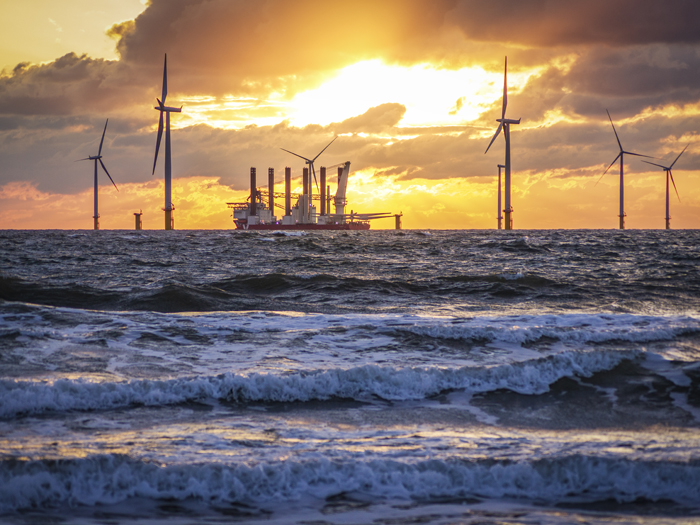Replacing Offshore Wind Turbines Costs Millions. What North American Operators Can Learn from Europe’s Loss Lessons

Offshore wind energy in North America is in the early stages of development, but insurance and risk management in the sector is already well established, at least in Europe.
“We are not starting from scratch,” said Michael Gosselin, global leader for energy and transition risk at Liberty Mutual.
“We already play an active role in the energy transition, from project financing through construction, operation and decommissioning.”
The U.S. has a stated goal of 30 gigawatts of offshore wind generating capacity installed and operating by 2030 ― only six and a half years away.
The next goal is a less definite ‘pathway’ to 110 GW by 2050. To put the scale of that ambition into perspective, there is about 50 gigawatts of installed offshore generating capacity worldwide in 250 developments, as of the middle of 2022, according to the U.S. Department of Energy.
“There is a strong track record for insurance and risk management for offshore wind in Europe,” said Gosselin.
“In our book of business we try to take the long-term view across the 25 years or more of a project’s life. That involves goods in transit for construction as well as a huge amount of human capital for installation, operation, and maintenance.” Liberty Mutual has been writing risks and consulting on projects worldwide. It has a global portfolio of $950 million in premium.
In Development
Modeling and pricing are still being developed.
“We do need a sustainable market over the long haul,” said Gosselin.
He noted that much of the North American offshore wind development is in areas prone to natural catastrophes, in particular named storms.
He added, “project cargo is a critical and often overlooked element for wind energy, both onshore and marine. That includes facilities such as port handling and lay down yards.”
In 2022, seven supporting syndicates granted Liberty Specialty Markets (LSM) authority to underwrite project cargo on their behalf with various brokers. As the sole leader, LSM will bind risks to Liberty Project Cargo Consortium (7763), including the ability to insure the impact of delays on project financing with up to $205 million of capacity. LSM writes the business 100% on this consortium, with a single stamp that binds all eight members.
“Components are getting bigger, to take advantage of economy of scale, and there are only a few turbine suppliers,” said Gosselin. “Platforms are evolving from fixed to floating, which is a huge challenge all by itself. To build this generating capacity, we are building a whole new [industrial and logistical] ecosystem that does not even exist yet.”
Coverage Considerations and Risks to Review
There are some initiatives to build wind-energy components in the U.S. Until those are in operation, “many of the turbines and other equipment are expected to come from overseas factories,” said Honorio Campos, underwriting manager at Allianz Global Corporate & Specialty.” Therefore trans-shipment will be required.
“With respect to the existing power infrastructure,” Campos continued, “we expect this will be adapted to be capable to handle the additional power supply in a similar way it has been handled for all the new onshore capacity, both conventional power as well as renewable, which is being added to the U.S. grid every year. There will be definitively a need for project-cargo and DSU coverage. The DSU component will be optional if the project-cargo policy is procured by the project owner.”
In other lines, Campos noted “the demand for builder’s risk and property coverages will continue to grow as these projects get the green light and financing. In the case of property coverage, once the project is completed, it might be either added to an existing property program or otherwise require a new policy.”
Campos explained that transmission and distribution lines are typically not covered in operational policies, except within a short distance from the generating plants or as individual lines declared under the policy.
“So for us as insurers, we would be mostly dealing with any business interruption following loss or damage to the power generating equipment,” he said.
A commonly cited number is $3 million for the replacement cost of a wind-turbine tower.
“That figure will cover a mid-size onshore turbine,” said Morten H. Jensen, technical manager and consulting engineer in wind technology at Sedgwick Denmark A/S. “I am currently involved in the claim from a fire in an 8-MW offshore wind turbine. The claim size is EUR 11 million, and in this case, the blades could be re-used.”
David Ward, head of power and energy at Sedgwick International UK, added, “It’s worth noting that offshore wind risks could involve vessel hire, which runs into £100,000 per day. Other risks such as sub-sea cabling and protection systems also attract high vessel or remote-operated-vehicle costs as well. Construction-phase risks including sub-sea cabling which can be in the region of £2.5 million to remove and replace.”
Another difference between on- and offshore turbines is lightning. On land, it’s often cited in claims as the cause of damage to electrical equipment and fires. Offshore, “it’s not lighting I see as the major problem,” said Jensen. “Most blades are currently well protected and can handle quite severe lighting strikes. Replacing major components like generators, main bearings, transformers will be the big thing of importance.”
A Discussion on Financing
Long development timelines have implications for project finances as well as for risk management.
“You don’t have a project until you have a lease [for the ocean area] and a power-purchase agreement [PPA],” said Benjamin Roberts, leader for Northeast power and renewables at Marsh.
Cost assumptions from just a few years ago probably did not account for the Russian invasion of Ukraine, a global pandemic and the subsequent inflation trends.
“Actual costs are up by double-digit percentages in the last couple of years relative to say 2018 or 2019,” said Roberts. “That puts pressure margins and project economics given PPA pricing may have been locked in with no adjustment for today’s market realities.”
Specific to insurance, “project-cargo and DSU insurance are usually covered by the owner’s construction all-risk policy,” said Roberts.
“The tier-one international contractors may own their own vessels and would have their own P&I program as part of their marine package. For their work on projects in the U.S., it is not uncommon to see the tier one contractors stand up a local programs of $10, $20, even $50 million to serve as a bit of a buffer to international master programs that may be in place to support their business operations in the rest of the world. Many international operators recognize that the U.S. is a more litigious region with a generally higher cost of risk relative to other locales.”
And Then There’s Maritime Legalities
The quirks of U.S. maritime law add an additional level of complexity.
Every nation has cabotage regulations; in the U.S., the main legislation is known as the Jones Act and mandates that any carriage from one domestic location to another — including a spot offshore — be done in vessels built and owned in the U.S. and staffed by American crews.
Because the Jones Act is a federal statue, maritime employer’s liability for the vessel’s crew are not part of workers’ compensation at the state level; others Federal legislation includes the Longshore & Harbor Workers’ Compensation program, known as USL&H. A provision to the latter specifically includes workers on offshore facilities.
“In terms of rate, U.S. projects will trade at a slight premium to Europe because of several risk factors,” said Roberts. “And given that the scheduling of these projects is a complicated, multi-variable logistical exercise, there are bound to be issues that may result in a delay.”
He stressed that “not every delay or scheduling complication is an insurable event.”
That is at the edge of holistic risk management where project managers need to assess which risks can be transferred and which cannot. For example, damage to a blade or nacelle would likely be a covered loss. However, if the time to repair or replace is extended because vessels, crews or components additional costs could be incurred that might not be covered subject to specific policy terms and conditions.
Another new variable in the equation is modeling for natural catastrophe exposures on the East Coast. There are decades of data for offshore oil and gas facilities in the Gulf of Mexico, but wind turbines in the Atlantic are new and different.
“As an industry, we do not have the robust database of loss experience to model against,” said Roberts. “We are working hard with several clients, our actuaries and risk engineers around the world to put some loss expectancies out there, at least to begin the dialogue,” said Roberts. &












